For beginner UAV pilots looking to master aerial photography, five essential tools can elevate your skills. Start with a lightweight camera drone under 250 grams for easy maneuverability and registration exemption. Add ND filters to control light exposure and enhance your shots. Invest in user-friendly editing software like Adobe Premiere Rush to polish your footage. Don't forget a portable charging station to keep your drone powered on long shoots. Finally, high-capacity, fast memory cards guarantee you never miss a moment. With these tools in your arsenal, you'll be well-equipped to capture stunning aerial imagery. Let's explore each tool in more detail.
Key Takeaways
- Lightweight camera drones under 250 grams offer easy entry for beginners and often avoid registration requirements.
- ND filters enhance aerial photography by controlling light exposure and improving motion blur effects.
- User-friendly editing software like Adobe Premiere Rush or GoPro Quik simplifies post-production for novice drone pilots.
- Portable charging stations with multiple ports keep drone batteries and accessories powered during field shoots.
- High-capacity, fast memory cards (Class 10 or UHS-I rated, 64GB+) ensure uninterrupted footage capture.
Lightweight Camera Drones
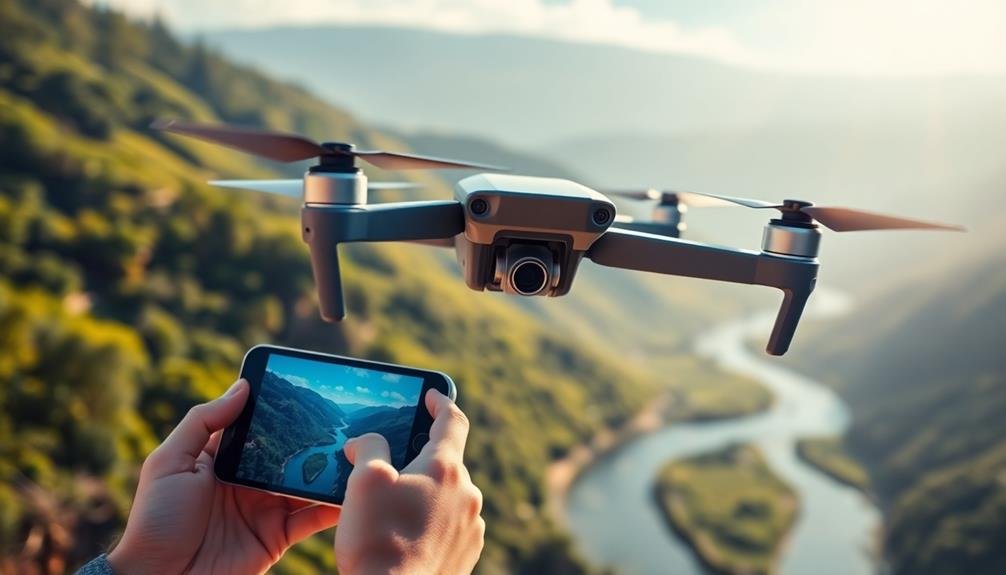
Frequently, beginner UAV pilots start their journey with lightweight camera drones. These compact flying machines offer an ideal entry point into aerial photography, combining ease of use with impressive image capabilities.
You'll find models weighing less than 250 grams, which often don't require registration in many countries, making them perfect for novice flyers.
Look for drones with built-in stabilization features like 3-axis gimbals to guarantee smooth footage. Many lightweight options now boast 4K video and high-resolution still photography, rivaling their larger counterparts.
You'll want to take into account battery life, typically ranging from 20 to 30 minutes for this category.
Popular features include obstacle avoidance sensors, automated flight modes, and smartphone connectivity for easy control and image sharing. Some models offer foldable designs, enhancing portability for on-the-go shooting.
As you gain experience, you can explore more advanced photography techniques like panoramas, time-lapses, and HDR imaging.
Remember to familiarize yourself with local drone regulations before flying. With practice, you'll quickly improve your piloting skills and capture stunning aerial shots that were once only possible with expensive equipment and crews.
ND Filters for Aerial Shots
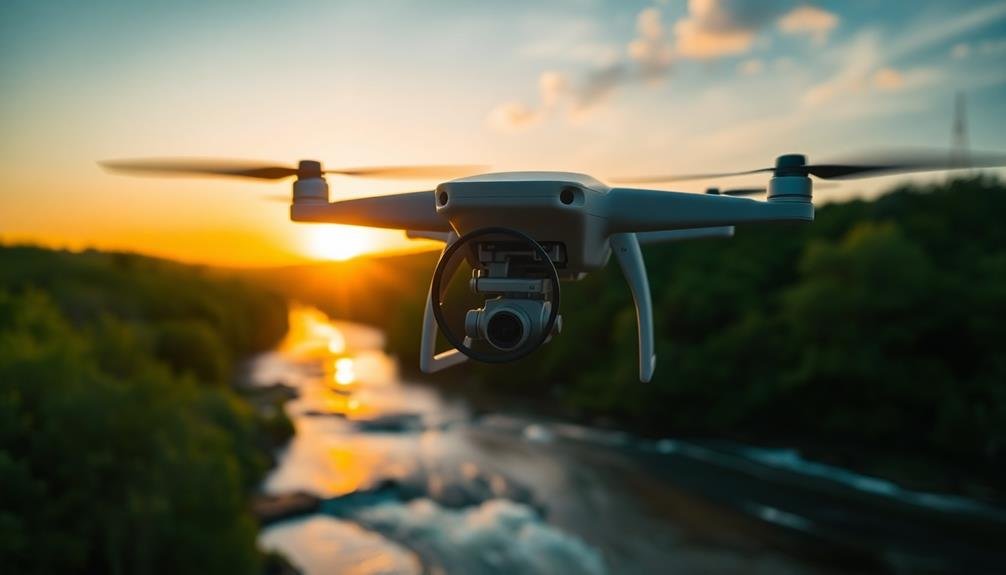
Occasionally, aerial photographers overlook the importance of ND (Neutral Density) filters for their drone shots. These essential tools can greatly enhance your aerial photography by allowing you to control light exposure and create stunning visual effects. ND filters reduce the amount of light entering your drone's camera sensor, enabling you to use slower shutter speeds or wider apertures in bright conditions.
When you're ready to elevate your aerial photography game, consider these benefits of using ND filters:
- Improved motion blur: Capture smooth, silky water or create dreamy cloud effects in your landscapes.
- Better exposure control: Maintain ideal aperture and shutter speed settings in bright daylight.
- Enhanced depth of field: Use wider apertures for a shallower depth of field, even in bright conditions.
- Cinematic footage: Achieve a more professional look in your drone videos with proper motion blur.
To get started, invest in a set of ND filters specifically designed for your drone model. You'll typically find them in various strengths, such as ND4, ND8, and ND16.
Experiment with different filter strengths in various lighting conditions to understand their effects on your images and videos. With practice, you'll master the art of using ND filters to capture breathtaking aerial shots.
Editing Software for Drone Footage
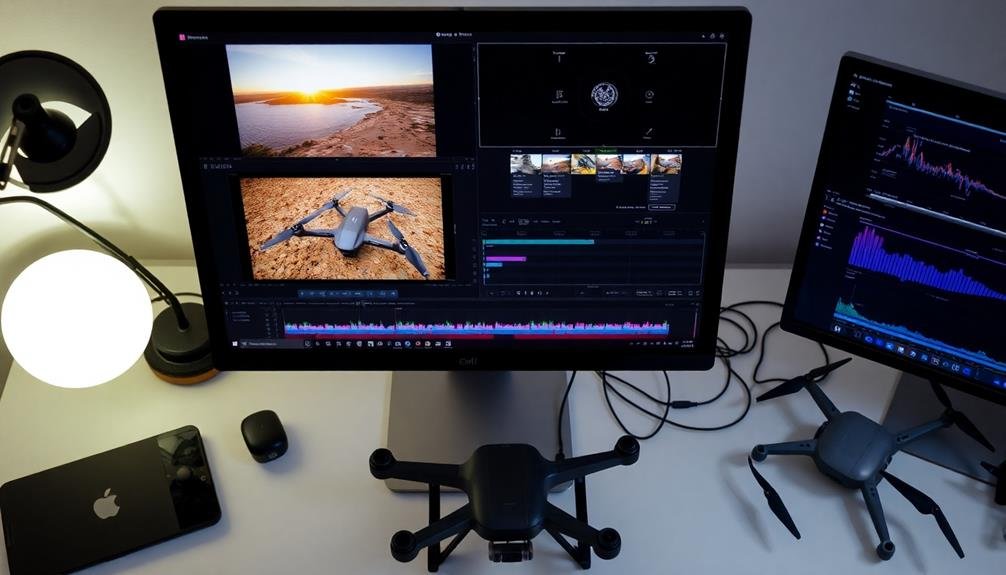
Once you've captured stunning aerial footage with your drone and ND filters, you'll need powerful editing software to bring your vision to life.
For beginners, user-friendly options like Adobe Premiere Rush or GoPro Quik offer intuitive interfaces and basic editing tools. These apps allow you to trim clips, adjust colors, and add simple changes on your smartphone or tablet.
As you advance, consider upgrading to more robust software like Adobe Premiere Pro or DaVinci Resolve. These professional-grade programs provide extensive color grading options, advanced audio editing, and motion graphics capabilities. They'll give you greater control over your footage but require a steeper learning curve.
For drone-specific editing, try Litchi or DJI Go 4. These apps offer features tailored to aerial footage, such as flight path visualization and telemetry data overlay. They're particularly useful for creating dynamic shots and adding context to your aerial videos.
Don't overlook the importance of color correction and grading.
Tools like LUTs (Look-Up Tables) can quickly enhance your footage's aesthetic. Many editing software packages include built-in LUTs, or you can download custom ones for a unique look.
Portable Charging Stations
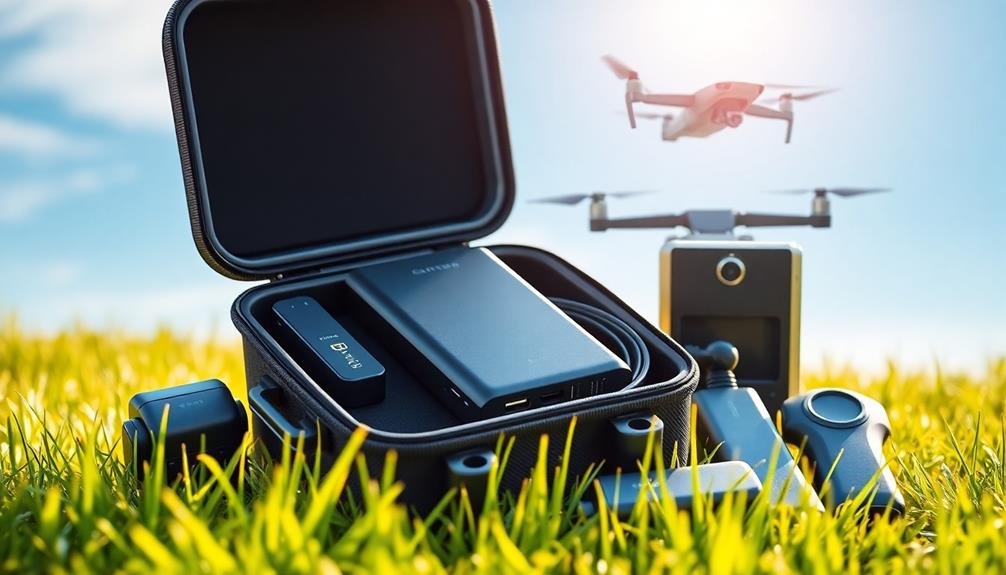
With extended flight times and power-hungry equipment, portable charging stations are essential for beginner UAV pilots. These devices allow you to keep your drone batteries, camera, and other accessories charged while in the field, guaranteeing you don't miss out on capturing that perfect shot.
When choosing a portable charging station, consider factors like capacity, portability, and compatibility with your specific drone model.
Look for charging stations that offer:
- Multiple charging ports to accommodate various devices
- Quick-charge capabilities for faster turnaround times
- Pass-through charging, allowing you to charge the station while it's in use
- Rugged construction to withstand outdoor conditions
Opt for a charging station with a capacity that matches your needs. If you're planning short outings, a compact 10,000mAh power bank might suffice. For longer trips or multiple battery charges, consider a larger 20,000-30,000mAh unit.
Don't forget to check the output voltage and amperage to guarantee compatibility with your drone's batteries. Some charging stations even come with solar panels, providing an eco-friendly option for extended outdoor use.
Memory Cards and Storage Solutions

The lifeblood of any drone photographer's workflow is reliable storage. You'll need high-capacity, fast memory cards to capture those breathtaking aerial shots without interruption. Opt for Class 10 or UHS-I rated SD cards with at least 64GB capacity. These guarantee quick write speeds, essential for 4K video recording and RAW image capture.
Don't forget about backup solutions. Portable SSDs offer a great balance of speed, capacity, and durability for on-the-go storage. Look for ruggedized options that can withstand the elements during your outdoor shoots.
Here's a quick comparison of storage options:
| Type | Capacity | Speed | Durability |
|---|---|---|---|
| SD Card | 64GB-512GB | Fast | Moderate |
| microSD | 32GB-1TB | Fast | Moderate |
| Portable SSD | 500GB-4TB | Very Fast | High |
When choosing storage, consider your shooting style and frequency. If you're capturing long 4K videos, you'll need more capacity and faster write speeds. For occasional still photography, lower capacity cards might suffice. Always carry multiple cards and regularly transfer your footage to a backup device to protect your valuable aerial captures.
Frequently Asked Questions
What Are the Legal Requirements for Flying a Camera Drone?
You'll need to register your drone with the FAA, obtain a Part 107 license for commercial use, and follow local regulations. Don't fly over people, near airports, or in restricted areas. Always keep your drone in sight.
How Can I Improve My Drone Piloting Skills for Better Aerial Photography?
To improve your drone piloting skills for better aerial photography, you'll want to practice regularly, master your drone's controls, learn composition techniques, and experiment with different camera settings. Don't forget to prioritize safety and follow local regulations.
Are There Specific Weather Conditions Best Suited for Drone Photography?
You'll get the best drone photos in calm, clear conditions. Shoot during golden hour for warm light. Avoid rain, strong winds, and extreme temperatures. Overcast days can provide soft, even lighting for certain subjects.
What Safety Precautions Should I Take When Flying a Camera Drone?
You should always follow local regulations, maintain visual line of sight, and avoid restricted areas. Don't fly in bad weather or near people. Check your drone's condition before flight and keep it charged. Stay below altitude limits.
How Do I Protect My Drone and Camera Equipment During Transport?
You'll want to invest in a sturdy, padded case for your drone and camera. Always secure loose parts, remove propellers, and use lens caps. Don't forget to protect batteries and keep them separate during transport.
In Summary
You're now equipped with the essential tools to elevate your drone photography game. From lightweight camera drones to ND filters, editing software, portable chargers, and storage solutions, you've got what you need to capture stunning aerial shots. Don't forget to practice and experiment with these tools to develop your skills. As you gain experience, you'll discover which equipment works best for your style. Keep exploring, and soon you'll be creating breathtaking aerial imagery like a pro.

As educators and advocates for responsible drone use, we’re committed to sharing our knowledge and expertise with aspiring aerial photographers.
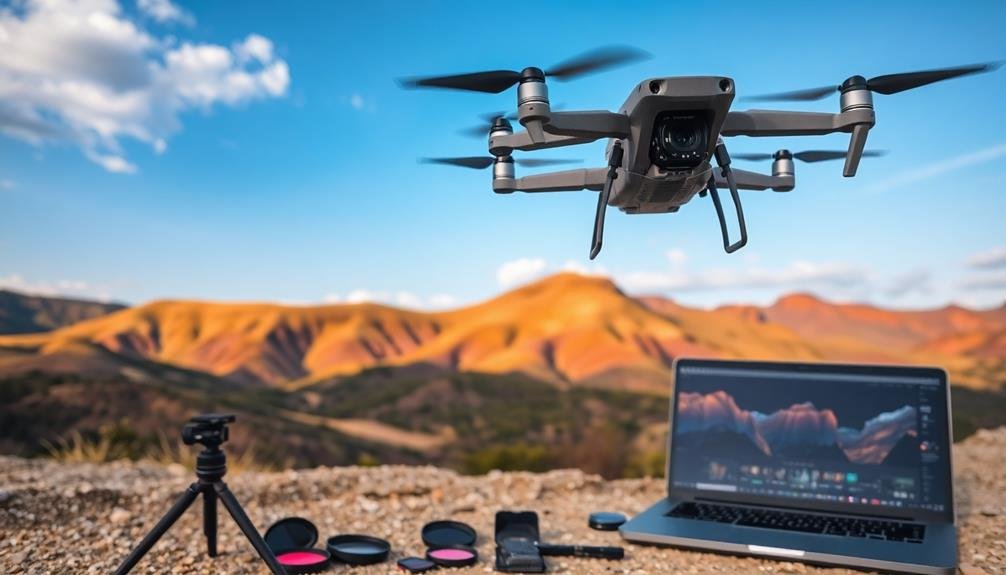



Leave a Reply